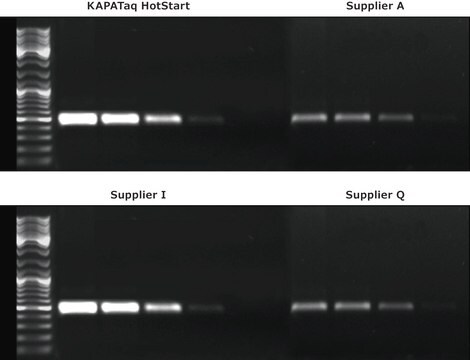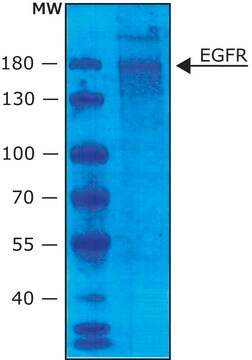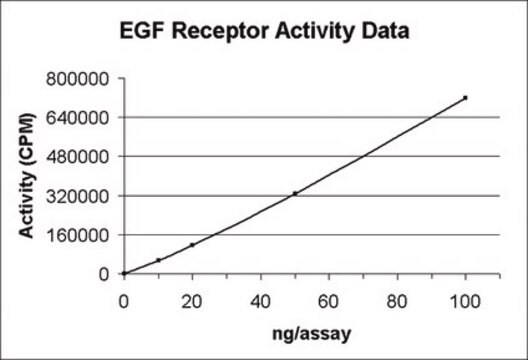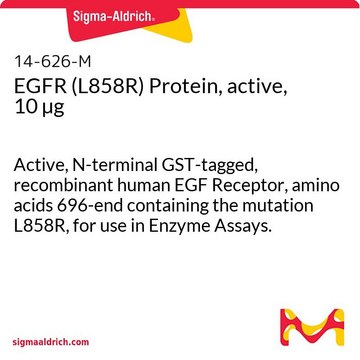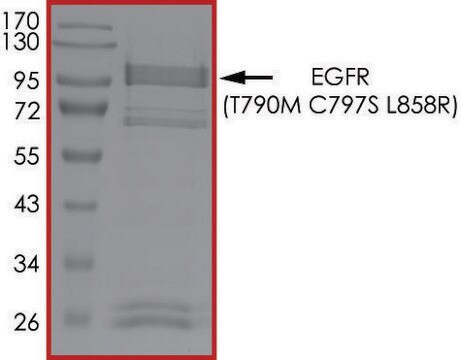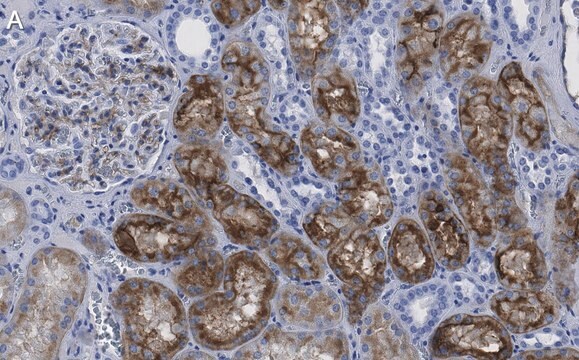SRP0242
EGFR (T790M L858R) Active human
recombinant, expressed in baculovirus infected insect cells, ≥70% (SDS-PAGE)
Sinónimos:
ERBB1, Epidermal growth factor receptor, HER1, PIG61, Proto-oncogene c-ErbB-1
Iniciar sesiónpara Ver la Fijación de precios por contrato y de la organización
About This Item
UNSPSC Code:
12352200
NACRES:
NA.32
Productos recomendados
biological source
human
recombinant
expressed in baculovirus infected insect cells
assay
≥70% (SDS-PAGE)
form
aqueous solution
mol wt
88 kDa
packaging
pkg of 10 μg
storage condition
avoid repeated freeze/thaw cycles
concentration
>0.02 mg/mL
NCBI accession no.
UniProt accession no.
shipped in
dry ice
storage temp.
−70°C
Gene Information
human ... EGFR(1956)
General description
Epidermal growth factor receptor (EGFR) can be activated by binding EGF or at least six other structurally related protein ligands, including transforming growth factor-α (TGF-α), heparin-binding EGF-like growth factor (HB-EGF), betacellulin (BTC), amphiregulin, epiregulin and epigen. Human EGFR T790M L858R (GenBank Accession No. NM_005228), (amino acids 668-1210) with N-terminal GST tag, MW = 88kDa, expressed in baculovirus expression system.
The EGFR gene is mapped to human chromosome 7p11.2 and encodes a 170 kDa receptor protein belonging to the HER (Receptor tyrosine-protein kinase erbB-4) family of receptor tyrosine kinases. Egfr is localized to epithelial cell surface.
The EGFR gene is mapped to human chromosome 7p11.2 and encodes a 170 kDa receptor protein belonging to the HER (Receptor tyrosine-protein kinase erbB-4) family of receptor tyrosine kinases. Egfr is localized to epithelial cell surface.
Application
Useful for the study of enzyme kinetics, screening inhibitors, and selectivity profiling.
Biochem/physiol Actions
Epidermal growth factor receptor (EGFR, ErbB1) is a transmembrane protein that exerts tyrosine kinase activity upon ligand induced activation. The receptor undergoes dimerization and phosphorylation of tyrosine kinase. Upon activation by ligands, epidermal growth factor receptor (EGFR, ErbB1) initiates a signaling cascade which includes dimerization and internalization, tyrosine phosphorylation, DNA synthesis of target genes, and, ultimately, cell proliferation. EGFR signaling plays a role in the growth and differentiation of normal cells, but elevated EGFR activity is correlated with the development and pathogenesis of certain cancers. Mutation in the EGFR gene is associated with the risk of tumor development including glioma, colorectal adenoma, colorectal, breast and non-small cell lung cancer.
Unit Definition
One unit is defined as the amount of enzyme that will phosphorylate 1 pmol of Tyr substrate per minute at pH 7.4 and 30°C.
Physical form
Formulated in 25 mM Tris-HCl, pH 8.0, 138 mM NaCl, 0.05% Tween-20, 50% glycerol and 3 mM DTT.
Preparation Note
Thaw on ice. Upon first thaw, briefly spin tube containing enzyme to recover full content of the tube. Aliquot enzyme into single use aliquots. Store remaining undiluted enzyme in aliquots at -70°C. Note: Enzyme is very sensitive to freeze/thaw cycles.
Elija entre una de las versiones más recientes:
Certificados de análisis (COA)
Lot/Batch Number
¿No ve la versión correcta?
Si necesita una versión concreta, puede buscar un certificado específico por el número de lote.
¿Ya tiene este producto?
Encuentre la documentación para los productos que ha comprado recientemente en la Biblioteca de documentos.
Effect of epidermal growth factor receptor gene polymorphisms on prognosis in glioma patients.
Li B, et al.
Oncotarget, 7(39), 63054-63054 (2016)
Molecular mechanisms of resistance to the EGFR monoclonal antibody cetuximab.
Brand TM
Cancer Biology & Therapy, 11(9), 777-792 (2011)
A chromosomal region 7p11.2 transcript map: its development and application to the study of EGFR amplicons in glioblastoma.
Eley GD
Neuro-Oncology, 4(2), 86-94 (2002)
Nuestro equipo de científicos tiene experiencia en todas las áreas de investigación: Ciencias de la vida, Ciencia de los materiales, Síntesis química, Cromatografía, Analítica y muchas otras.
Póngase en contacto con el Servicio técnico